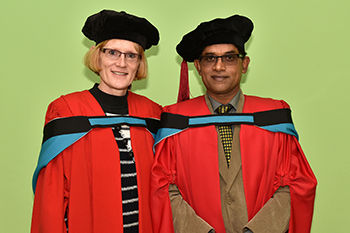Latest News Archive
Please select Category, Year, and then Month to display items
14 June 2024
|
Story Anthony Mthembu
|
Photo Suplied
 Jeremiah Hlahla, a UFS student completing his PhD in Botany at the University of Debrecen as part of an exchange initiative funded by the Erasmus+ Mobility Programme.
Jeremiah Hlahla, a UFS student completing his PhD in Botany at the University of Debrecen as part of an exchange initiative funded by the Erasmus+ Mobility Programme.
As part of an exchange initiative facilitated by the Erasmus+ Mobility Programme, Jeremiah Hlahla, a student at the University of the Free State (UFS), is nearing the completion of his PhD studies at the University of Debrecen in Hungary. Hlahla’s journey, which began in February 2024 and is set to conclude in July 2024, has been a remarkable learning opportunity. “As a first time-traveller to Europe, I have thoroughly enjoyed engaging with people from different countries and cultures,” he said.
The benefits of international collaboration
Hlahla is currently pursuing a PhD in Botany, focusing on plant stress physiology. “My current PhD project investigates the physiological, biochemical and morphological responses of vegetable-type soybean, or edamame, to combined drought and heat stress,’’ he explained. He considers the University of Debrecen the ideal institution to complete his research due to its extensive expertise and resources in similar projects. He noted that his colleagues at Debrecen conduct significant work on plant protection against biotic and abiotic stresses, including salt and drought stress, as well as proteins and amino acids in barley and other legumes.
Given the vast knowledge available on similar projects, Hlahla has found substantial engagement with his work at the University of Debrecen. “Upon arrival, I delivered an introductory lecture presenting my UFS project on the synergistic effects of combined drought and heat stress on the physiology and biochemistry of edamame. It was an engaging session as everyone could relate to my work and asked many questions,’’ he said.
Insights gained from the exchange
Hlahla has also gained valuable lessons that will assist him in his research career, including biotechnology and physiology tools. “I learned how to prepare samples and use high-performance liquid chromatography (HPLC) and reversed-phase ultra-high-performance liquid chromatography (UHPLC) to quantify proteins and amino acids,’’ he said. These techniques are beneficial not only for his current work but will also support future soybean research.
As his experience at the University of Debrecen nears its end, Hlahla reflects on the collaborations and friendships he has formed, which stand out as a significant highlight.
Using sugar to make the world a sweeter place
2017-10-13

Dr Deepack Santchurn, former PhD student in the
Department of Plant Sciences at the UFS,
and plant breeder in the Mauritius Sugar Industry
Research Institute, with Prof Maryke Labuschagne, left,
Dr Santchurn’s study leader.
Photo: Charl Devenish
Besides it mainly being used for sugar production, sugarcane has emerged as an important alternative for providing clean renewable energy. Dr Deepack Santchurn, who works in the sugarcane breeding department of the Mauritius Sugar Industry Research Institute (MSIRI), believes if he could contribute towards a more environment-friendly and renewable energy through the use of sugarcane biomass, he would consider himself having made a great leap towards a better world.
Sugarcane is mostly known and exploited for the sugar in its cane stem. According to Dr Santchurn it is not the only thing the crop does well. “Together with certain grasses, it is the finest living collector of sunlight energy and a producer of biomass in unit time. Sugarcane is now recognised worldwide as a potential renewable and environment-friendly bioenergy crop.”
Significantly more bioenergy can be produced from sugarcane if the production system is not focused on the production and recovery of sucrose alone but on the maximum use to the total above-ground biomass. Diversification within the sugarcane industry is of paramount importance.
He has been able to identify a few high biomass varieties that can be exploited industrially. One of the varieties is a commercial type with relatively high sugar and low fibre in the cane stem. Dr Santchurn explains: “Its sucrose content is about 0.5% less than the most cultivated commercial variety in Mauritius. Nevertheless, its sugar yield and above-ground biomass yield surpass those of the commercial varieties by more than 24%. The genetic gains compared to commercial varieties were around +50% for total biomass yield and +100% for fibre yield. Its cultivation is strictly related to bio-energy production and the extracted juice can be used as a feed-stock for ethanol and other high-value products.”
Dr Santchurn received his PhD at the UFS’s Department of Plant Sciences during the Winter Graduation Ceremonies in June this year. His study leader was Prof Maryke Labuschagne from the Department of Plant Sciences.